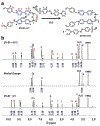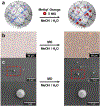Electrostatic loading and photoredox-based release of molecular cargo from oligoviologen-crosslinked microparticles
- PMID: 36188127
- PMCID: PMC9518833
- DOI: 10.1039/d2py00249c
Electrostatic loading and photoredox-based release of molecular cargo from oligoviologen-crosslinked microparticles
Abstract
Although on-demand cargo release has been demonstrated in a wide range of microparticle platforms, many existing methods lack specific loading interactions and/or undergo permanent damage to the microparticle to release the cargo. Here, we report a novel method for electrostatically loading negatively charged molecular cargo in oligoviologen-crosslinked microparticles, wherein the cargo can be released upon activation by visible light. A water-in-oil (W/O) emulsion polymerization method was used to fabricate narrowly dispersed microparticles crosslinked by a dicationic viologen-based dimer and a poly(ethylene glycol) diacrylate. A zinc-tetraphenyl porphyrin photocatalyst was also polymerized into the microparticle and used to photochemically reduce the viologen subunits to their monoradical cations through a visible-light-mediated photoredox mechanism with triethanolamine (TEOA) as a sacrificial reductant. The microparticles were characterized by microscopy methods revealing uniform, spherical microparticles 481 ± 20.9 nm in diameter. Negatively charged molecular cargo (methyl orange, MO) was electrostatically loaded into the microparticles through counteranion metathesis. Upon irradiation with blue (450 nm) light, the photo-reduced viologen crosslinker subunits lose positive charges, resulting in release of the anionic MO cargo. Controlled release of the dye, as tracked by absorption spectroscopy, was observed over time, yielding release of up to 40% of the cargo in 48 h and 60% in 120 h in single dynamic dialysis experiment. However, full release of cargo was achieved upon transferring the microparticles to a fresh TEOA solution after the initial 120 h period.
Conflict of interest statement
Conflicts of interest The authors declare no conflict of interest.
Figures





References
-
- Subramanian V, Microspheres: Technologies and Global Markets, 2018.
-
- Franssen O and Hennink WE, Int. J. Pharmaceut, 1998, 168, 1–7.
-
- Xia YJ and Pack DW, Chem. Eng. Sci, 2015, 125, 129–143.
-
- Kozlowska J, Prus W and Stachowiak N, Int. J. Biol. Macromol, 2019, 129, 952–956. - PubMed
Grants and funding
LinkOut - more resources
Full Text Sources
